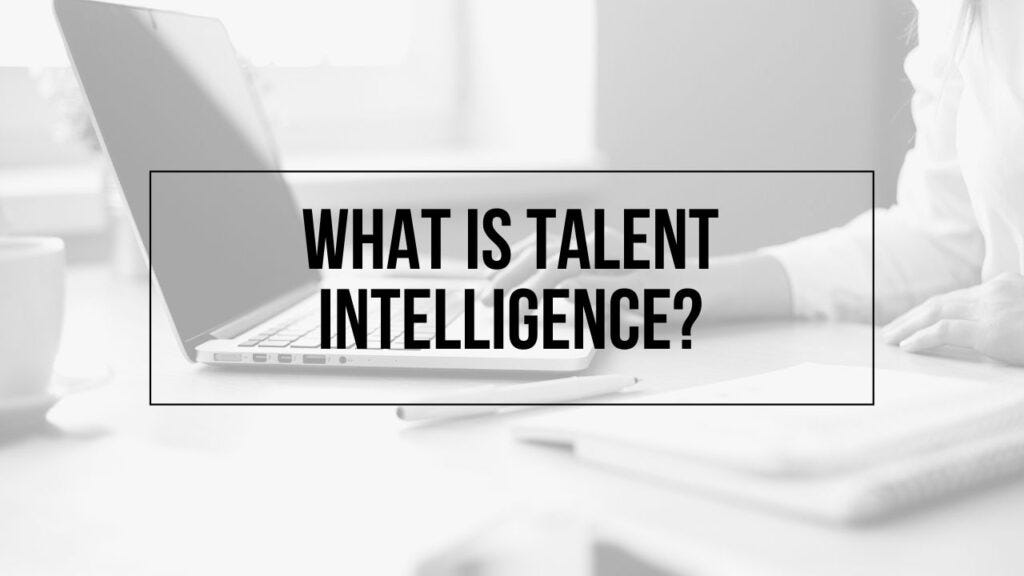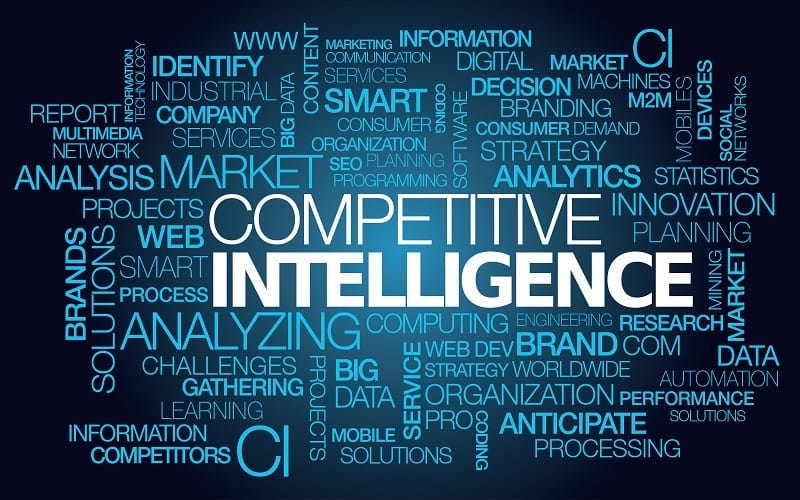This is a collaboration piece between Cole Napper & Toby Culshaw
This article is written to discuss: using talent intelligence as a mechanism for gathering competitive intelligence for your organization.
Context
At an earlier stage in Cole's career, he received feedback from an internal stakeholder as a part of a 360 degree feedback assessment about his performance. It said: “Cole has a maniacal focus on adding value to the business”. Sadly, it wasn’t a compliment, but Cole took it as a badge of honor. It’s important to understand this perspective as Cole and Toby write about people analytics, and in this case talent intelligence. We are writing from the perspective of people who are trying to maximize the value of information for the benefit of an organization – in essence to try to create competitive advantage for an organization. Hence, this article on how to gain competitive intelligence for your organization via talent intelligence.
Source
What is Talent Intelligence?
In Toby’s book, aptly named “Talent Intelligence”, he provides a widely accepted definition of Talent Intelligence:
“Talent Intelligence is the augmentation of internal and external people data with the application of technology, science, insights, and intelligence relating to people, skills, jobs, functions, competitors, and geographies to drive business decisions.”
(If you curious to learn more about Talent Intelligence, we recommend you join the Talent Intelligence Collective)
As a field, talent intelligence is still new, and largely ill-defined, but due to the impact of Covid-19 and the associated increase in labor market volatility talent intelligence is arguably the single-fastest growing area of HR. The world faces an unprecedented talent shortage in the next decade as a result of a mismatch between business needs and available skills.
“Global labor shortages of 85.2 million skilled workers are projected by 2030, resulting in lost revenue opportunities of $8.452 trillion – the combined GDP of Germany and Japan. The United States alone could miss out on $1.748 trillion in revenue due to labor shortages, or roughly 6% of its entire economy ".
Given this context having an integrated and strategic holistic talent intelligence strategy will be vital for future sustainable growth for companies.
There are many facets to talent intelligence from location strategy, skills intelligence, future intelligence, talent sentiment, persona intelligence, DEI intelligence and by many definitions expanding into talent management analytics, sourcing intelligence, talent acquisition analytics, recruitment marketing analytics, but arguably one of the fastest growing and impactful areas (given it’s breadth) is that of competitor talent intelligence.
By analyzing your competitors' workforce, you can gain valuable insights into their strategy, strengths, and weaknesses. This information can be used to inform your own strategy and gain a competitive advantage in the marketplace. If you are looking for ways to gain an edge over your competitors, consider incorporating talent intelligence into your overall competitive intelligence strategy. The insights gained from talent intelligence can help you make informed decisions about your workforce, your competitors, and your overall business strategy.
Competitive Intelligence - An Example
When Cole was working for a prior employer a few years ago, he researched data on talent flows between organizations. He noticed an interesting piece of information. Hundreds, if not thousands, of engineers from Intel were leaving to join Apple, in addition engineers from a few other semiconductor organizations. Cole couldn’t make heads or tails of that information at the time. Fast forward a year or two into the future, and in 2020 Apple announced that it was dropping Intel as it’s provider for semiconductor chips and that it would be designing its microchips in-house — a first for the organization. This was a huge competitive blow to Intel and a large strategic shift for Apple. Both of these findings were detectable months, if not years, in advance using one key piece of information: Talent Intelligence.
What are the implications of having talent intelligence in this instance? If you work at Apple or Intel, the implications are obvious. Intel must do better to retain its top engineers. Apple is creating a “mote” by designing top performing semiconductor chips in house, while adding additional cost in the form of headcount to their operations. The implications for investors were to see the “writing on the wall” to diversify their portfolio away from Intel. However, what if you worked for Samsung or another Apple competitor? From a strategic standpoint, if Intel is your provider for innovative semiconductor chips, it is probably time to start acquiring semiconductor talent in-house as well because Intel is likely to be less innovative; while your direct competitor, Apple, will not have its innovation hindered. As referenced in a prior article, Apple might even be hiring more talent than they need just so their competitors don’t have access to it. Much food for thought…
Source
Using Talent Intelligence to Gain Competitive Intelligence
By analyzing your competitors' workforce, you can gain valuable insights into their strategy, strengths, and weaknesses. For example, by analyzing the skills and experience of your competitors' employees, you can gain insights into the types of products or services they are likely to offer. Additionally, by analyzing employee turnover rates, you can gain insights into the overall health of your competitors' business.
Another way to use talent intelligence to gain a competitive advantage is by analyzing your competitors' recruiting efforts. By analyzing their job postings, you can gain insights into the types of talent they are looking for and the skills they value. Not only can this information can be used to inform your own recruiting efforts and ensure that you are attracting the best talent in the industry. Looking at competitor job adverts can be one of the fundamental pillars in developing an Always on Intelligence program.
Always on Intelligence (AoI) is a programmatic approach to talent intelligence where you run permanent campaigns of work (always on) against specific competitor groups. AoI is a tool that can be built out to act as a talent radar for early warning threat detection. If a competitor is opening up a new R&D in a location that is a threat you can see it coming. If they are looking to pivot as an organization and threaten our position in a market and show this by hiring news skills or if they are looking at expanding into new markets and have brought in new leaders to disrupt this and threaten our position, you would have it on your radar. If a competitor is looking to ramp up their technical team are you exposed as a potential source of hire? Are competitors shifting from on premise sales to cloud sales or from product sales to solutions? Are they launching new geographies? Are they pivoting to a new product line that they haven't been in before? And, most importantly, how do you tie this in to marketing intelligence to show the potential risk exposure by all of this happening and] make our leadership team aware ahead of time
Furthermore, talent intelligence can provide you with valuable insights into the talent market. By analyzing the labor market, you can gain insights into the supply and demand for talent in your industry at a more macro level. This information can help you make informed decisions about your hiring strategy and ensure that you are able to attract and retain the best talent in the industry.
Talent intelligence can also help you identify potential acquisition targets. By analyzing the workforce of potential acquisition targets, you can gain insights into their strengths and weaknesses, as well as the potential synergies that could be created through an acquisition. This information can help you make informed decisions about potential mergers and acquisitions and ensure that you are able to maximize the value of your investments.
Talent Intelligence Use Cases for Gaining Competitive Advantage
In research for this article, we batted around ideas with others to answer the question: Could talent intelligence be used to derive competitive intelligence for firms? Here are some ideas that arose:
-
Competitive Intelligence - Much like the Apple/Intel example earlier, it is difficult to know exactly what type of intelligence will be found about your competitors using talent intelligence, but only naive organizations wouldn’t environmentally scan the competitive landscape for intelligence about their competitors. In this case, for talent intelligence implications.
-
Net Talent Gain - Dr. John Sullivan recently wrote an article about how competitive advantage can be gained using talent intelligence by quantifying the firm’s net talent gain. Net talent gain is operationally defined as: “This is by comparing the number of employees that your recruiters directly hired away from each individual competitor company directly with the number of your employees that each individual firm has successfully poached from your company.”
-
Bringing Talent Intelligence “In-House” - Talent intelligence data is sometimes seen as a commodity, for which all players in the market have equal access to the data. Therefore, consultants are often used as an entry-way into using TI to gain insights. However, by building an “insourced” TI team your organization will gain unique knowledge about your industry and its talent dynamics that are not available on the public market. Internal knowledge will plug gaps in the publicly available data, which is one of the large shortcomings of talent intelligence for the time being. Companies who insource a TI function will benefit from a competitive standpoint over those who outsource.
-
Measuring Hiring Attribution - Who are the recruiters/sourcers bringing in the strongest talent? What hiring managers are best at assessing talent? Talent intelligence can assist an organization outcompeting its peers via measuring and prioritizing resources to people who bring in the best talent, with “talent” being quantified by quality of hire. By using talent intelligence and quality of hire, it becomes quite easy to prove the ROI of talent intelligence at your organization.
-
Empty Seat Time - This is one of Toby’s favorite metrics. Traditionally, Finance functions would calculate that if a role was open it was saving the company money for the duration of the job listing due to not paying for overhead. However, using talent intelligence the “as if” costs of having a role open for 3 months versus what would have occurred had that role been filled immediately with an above average employee can be determined.
-
Pay Transparency - Financial accounting incentivizes organizations to treat employee labor costs as liabilities rather than assets, as Cole has written about before. Yet, with recent legislation changes, pay transparency requirements are on the rise. With access to this new publicly available data, talent intelligence is increasingly able to normalize job architecture across organizations, get dynamic insights into pay trends, and as a consequence organizations can respond strategically to making pay decisions. Although, be on the lookout for potential changes to removing safe harbors for companies using third-party compensation data for antitrust purposes.
A theme amongst these use cases is to be different. If you know every firm recruits talent the same way, has the same hiring process, does headcount planning the same way, and/or does budgeting the same way, you can only gain advantage by seeing the flaws in the status quo and filling the gaps via insights gained through processes like talent intelligence. One example of this would be the gap of assessing culture as a part of talent intelligence. Cole’s employer, Orgnostic, has an open-source product in Beta called Nazar, which is experimenting at augmenting traditional labor market data — which is primarily what constitutes talent intelligence data today — with publicly available data about an organization’s and industry’s culture, based on the Denison culture model. If you’d like to learn more about the possibilities of merging culture data with labor market data, reach out to Cole.
Source
What’s Next?
Recently, speaking with a prominent member of the HR Tech community, Cole made the following proclamation: “Inflation will kill skills”. Skills and associated topics (e.g., upskilling, reskilling, skills inventories, and skills inference, etc.) were all the rage in 2021 and 2022. Those days are quickly coming to a close. 2023 is the year where all “skills-based investments” will need to start paying off. We are doubtful they will. With the cost of capital rising and layoffs pervading, organizations are needing to run more lean. Skills investments likely won’t make the cut quickly enough. Pet projects, such as skills, are a luxury belief that organizations can no longer afford.
2023 is the “end of the beginning” of people analytics and talent intelligence. What happens in the economy with inflation, credit crunches, and economic pressures on the workforce will shape the future of talent intelligence’s impact on organizations. Organizations who invest in using talent intelligence to create competitive advantage are positioned to come out the other side stronger than ever. Be one of those organizations.
We hope you like this article. If so, more articles are coming out soon. Stay tuned. If you are interested in learning more directly, please connect with Cole on LinkedIn.
Bios
Cole Napper is the Co-Host of Directionally Correct, A People Analytics Podcast with Cole & Scott and owner of Directionally Correct LLC. He is also the Vice President of People Analytics & Product Evangelist for Orgnostic, an innovative people analytics, generative AI, data orchestration, & employee listening platform. Cole has 12+ years of rapidly escalating experience building HR centers of excellence from the ground up to scale — with an expert focus on People Analytics. He creates competitive advantage using People Analytics for companies big (Texas Instruments, Toyota, PepsiCo) & not-so-big (Orgnostic, Motive, Booster).
Toby Culshaw is the Talent Intelligence Leader at Worldwide Amazon Stores, leading a diverse global team of economists, consultants, business analysts and researchers in talent intelligence. Previously, he was Global Head of Talent Intelligence and Executive Recruitment Research at Royal Philips, the Dutch health technology group. He was named by Recruiter Magazine as one of the 11 Most Influential In-house Recruiters in 2017 and has consistently ranked every year from 2019 until 2022, is an international speaker on sourcing, executive research and talent intelligence and author of the best-selling Talent Intelligence: Use Business and People Data to Drive Organizational Performance. Based in Brighton, UK he is also the founder of the Talent Intelligence Collective (with its Facebook Group, Newsletter and main TIC Hub) , a Talent Intelligence Mentor at Udder and a co-host of the Talent Intelligence Collective Podcast.



